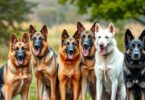Nearly 50 million years ago, a common ancestor roamed Earth—a creature that would later branch into species as different as chihuahuas and grizzly bears. This shared lineage might explain why these animals occasionally display similar behaviors, like digging or scavenging.
Both belong to the Caniformia suborder, a group within Carnivora that includes raccoons, seals, and weasels. Members of this family share traits like nonretractile claws and plantigrade paws (walking on the entire sole). These features differ sharply from Feliforms like cats, which have retractable claws and digitigrade feet.
North America served as a hotspot for their diversification. From the Eocene era onward, evolving climates and ecosystems allowed early Caniforms to adapt into specialized roles. Modern genetic studies reveal surprising overlaps in DNA, suggesting a closer kinship than their appearances imply.
This article examines fossil records, anatomical similarities, and molecular evidence to untangle their evolutionary paths. You’ll discover how physical traits and survival strategies connect species separated by millions of years. Whether you’re a pet owner or wildlife enthusiast, this exploration offers fresh insights into nature’s interconnectedness.
Exploring the Evolutionary Journey of Caniforms
Long before modern ecosystems formed, small tree-dwelling mammals shaped the future of caniforms. These agile creatures developed traits that would later define an entire suborder of carnivorans. Their story begins in dense forests, where survival depended on climbing and grasping.
Origins of Tree-Climbing Carnivorans
Around 43 million years ago, Miacis—a fox-sized mammal—scampered through ancient trees. Its flexible ankles and sharp claws allowed it to hunt insects and evade predators. Fossils suggest it looked like a mix between modern raccoons and civets, with adaptations for vertical movement.
Defining the Caniformia Suborder and Its Traits
The Caniformia group includes mammals like raccoons, weasels, and seals. Unlike feliformia species (such as cats), they share nonretractile claws and walk flat-footed. For example, polar bears use these plantigrade paws to distribute weight on ice.
Over millions of years, two species split from early caniforms: dog-like hunters and bear-like omnivores. Despite differing diets, their genetic relationship explains shared behaviors like digging. This connection helps answer why distant cousins like dogs and bears sometimes look alike.
Investigating if Bears are Related to Dogs
Cutting-edge genetic analysis reveals hidden connections between species that physical traits alone can’t explain. By comparing DNA sequences, researchers uncover evolutionary relationships buried deep within the order Carnivora.
Genetic Evidence and DNA Insights
Studies using molecular phylogenetics—like those by Flynn and colleagues—identify shared genetic markers across species. Specific genes regulating tooth development and digestion show striking similarities. These molecular patterns suggest a split from a common ancestor approximately 40 million years ago.
Phylogenetic Studies and Evolutionary Timelines
Evolutionary trees built from mitochondrial DNA place modern animals on branching timelines. Mutations in conserved regions act as molecular clocks, dating when species diverged. For example, a 2018 study found a 96% match in regulatory genes between certain members of the order Carnivora.
Such findings confirm that distinct survival strategies—like a wolf’s hunting versus a bear’s foraging—evolved long after their genetic separation. Yet remnants of shared ancestry persist in unexpected ways, from bone structure to immune responses.
Diverse Lineages and North American Connections
The vast landscapes of ancient North America became a stage for evolutionary innovation among carnivorans. Shifting climates and varied ecosystems allowed species to adapt into distinct ecological roles, creating a tapestry of caniform families that thrive today.
The Role of North America in Caniform Diversification
During the Eocene and Miocene epochs, North America’s forests and plains nurtured specialized carnivoran clades. Fossil records show ursids (bear family) and canids (wolf family) diverging here, adapting to niches from forest foraging to pack hunting. These groups share traits like nonretractile claws—ideal for digging or gripping prey—but evolved unique body sizes. For example, black wolves developed lean frames for endurance, while brown bears grew massive to dominate diverse habitats.
Comparisons with Raccoons, Mustelids, and Pinnipeds
Raccoons exemplify adaptability with their dexterous paws, while mustelids like otters evolved streamlined bodies for aquatic life. Pinnipeds (seals, walruses) branched further, trading land mobility for marine efficiency. Despite differences, all belong to the Carnivora order. Their shared North American roots explain why lions—feliforms with retractable claws—lack the plantigrade stance common in caniforms.
Final Reflections on the Caniform Connection
Genetic blueprints and fossilized remains reveal a story of shared ancestry that reshapes how we view modern carnivores. DNA analysis confirms that species within the Caniformia suborder—from foxes to walruses—descend from common ancestors, despite their varied sizes and habitats. These molecular clues align with fossilized teeth patterns and bone structures, offering concrete evidence of evolutionary paths diverging over millions of years.
Consider the giant panda: its bamboo diet and thumb-like wrist bone showcase unique adaptations, yet its DNA still links it to other ursids. Similarly, Arctic foxes and domestic cats illustrate how environmental pressures shape distinct survival strategies within the same suborder. Even pinnipeds like walruses, though adapted to marine life, retain genetic ties to land-dwelling carnivores.
This exploration answers longstanding questions about biological relationships while highlighting nature’s creativity. By studying both ancient fossils and modern genomes, scientists uncover how diverse groups evolved specialized traits without losing their genetic kinship. The narrative isn’t just about differences—it’s about the remarkable ways life adapts while preserving echoes of its origins.
Understanding these connections deepens appreciation for nature’s interconnectedness. Whether observing a panda’s teeth or a wolf’s hunting style, every trait tells a chapter in the Caniformia story—one where unity and diversity coexist in evolutionary harmony.
FAQ
How closely are bears and dogs connected evolutionarily?
Both belong to the Caniformia suborder within Carnivora, sharing a common ancestor roughly 40–50 million years ago. While they diverged into distinct lineages, traits like non-retractable claws and omnivorous diets highlight their shared evolutionary path.
What genetic evidence links these two species?
DNA analyses reveal similarities in genes tied to digestion, skeletal development, and sensory perception. For example, polar bears and wolves show overlapping adaptations for hunting, reflecting parallel evolutionary pressures despite geographical separation.
Did North America play a role in their diversification?
Yes. Fossil records suggest North America served as a hub for early caniforms. Species like ancient ursids and canids evolved unique traits here, such as enhanced嗅觉 for tracking prey, which later spread to other continents.










Leave a Comment